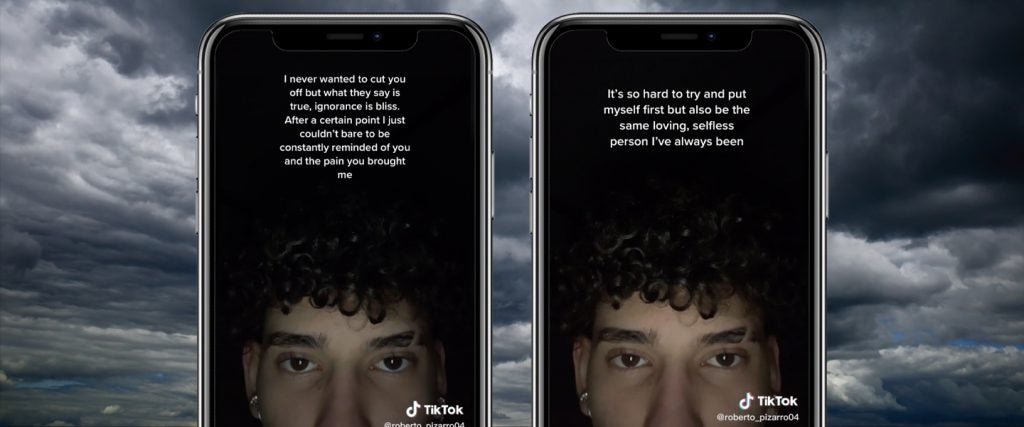When 19-year-old Roberto launched his TikTok account in the spring of 2021, he started by posting videos joking about what it’s like to be skinny and being told to lift more, or the experience of skipping finals to party. But a few months later, struggling to get over his ex, he decided to make a different kind of video. Captioned “A Letter to Her,” the clip shows his despondent, blinking eyes along with the text, “It took a lot of maturing to go from only wanting you to only wanting what’s best for you.”
“I knew my friends had heard about the situation enough, and I posted it to not bother them, I guess,” Roberto tells me. This was also the first time he tried using the hashtag #PainTok. It wouldn’t, however, be the last. Roberto was already feeling buoyed after he “got a surprising amount of support for such a small following,” which to him just confirmed that “there were so many people that were in the same boat I was in.”
Crying selfies are about as old as social media itself, but TikTok has opened up a new avenue for young men to share their crying selfies and find support from others for their emotional vulnerability through hashtags like #PainTok and #SadTok. Although these videos don’t always feature a guy crying, PainToks do have a few things in common. There’s typically somber music, followed by text over a sad image — a guy waiting for a train, sitting in a thunderstorm or tearing up to Olivia Rodrigo. But the most consistent through-line is guys expressing some sort of alienation — romantic or otherwise — and receiving moral support in the comments.
To therapists like Brittany Morris, there’s something about TikTok that’s had “an amazing impact in allowing people to feel safe in showing vulnerability, find community and feel supported.” Much of this conveniently lines up with the decreasing stigma around mental health, especially for men. But Morris suspects the rise of #PainTok is mostly a product of young men seeing their peers posting more emotionally driven content and feeling secure enough to try it themselves. “There are obviously upsides to seeing more men and male-identified individuals being open and vulnerable,” Morris explains. “It could create more empathy in our society, which is never a bad thing.”
The pandemic has also likely played a large role in the recent evolution and masculinization of the crying selfie, says Tara Well, an associate professor of psychology at Columbia University. In her book, Mirror Meditation, which examines how reflections influence our emotional health, Well suggests the decrease in face-to-face contact, combined with increased contact in masks, has made more people want to post content of their faces to compensate for this loss. “Research shows that we need face-to-face contact in real-time to process our emotions. Crying selfies might be a bid to get this reflection,” Well explains, warning, though, that this “can often backfire because they don’t really meet the need for in-person human reflection.”
Moreover, after a closer examination of #PainTok, Well notes that the music, text and high level of stylization actually distances the creators from their emotions. “These men are objectifying themselves — that is, treating themselves as things to be looked at instead of deeply connecting with others,” Well says. The favorites and comments may produce a short-lived dopamine hit, but again, Well believes face-to-face support will always be more impactful.
Other experts, like therapist Neena Lall, are also wary of the rise of #PainTok, given the similarities to past trends. Case in point: In 2019, Indian TikTok saw a number of young men posting similar crying videos, which at first seemed like genuine examples of emotional expression. But Lall says the trend was actually motivated by a “Bollywood archetype of a man wronged romantically who later seeks revenge.”
While some #PainTok posts discuss depression and other aspects of mental health, many of them, Roberto’s included, are focused on heartbreak. Although this might seem like a gesture of vulnerability among more emotionally available Gen-Z guys, Lall argues that it “doesn’t actually seem like a major shift in masculinity,” but rather “a continuation of a recurring theme.” Basically, the downcast, heartbroken man is a tired trope that shows up in just about all aspects of culture.
“All of these trends cast the sad and often romantically rejected man as a noble hero of sorts and are a long accepted mode of masculinity,” Lall continues. “With such context, we can see that this particular display of crying actually reinforces patriarchal notions of male entitlement and ownership of their lovers.”
That would certainly explain why the internet has largely been so accepting of #PainTok, as opposed to men crying in real life. It’s not that these videos are a sign of de-stigmatization of mental health or that it’s now more acceptable for young men to show emotion. It’s simply that people are generally accepting of this display of emotionality because it’s more of the same.
Nonetheless, Roberto says he created his #PainTok video through a genuine desire to share his feelings and find support. And while he continues to lean on his friends offline, he has found that TikTok helps in areas where his peers lack in life experience. “Hearing from people who have been in similar situations and are better now has helped me grow as a person and heal accordingly,” Roberto says.
Which is to say, on TikTok at least, there’s a whole app full of people who feel his pain.

